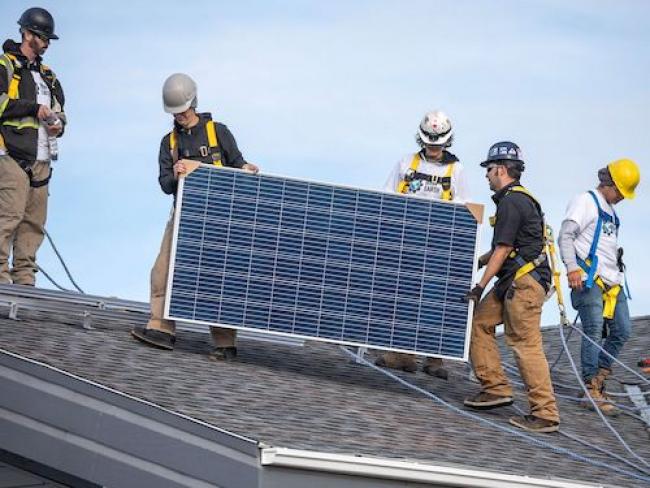Articles Menu

July 29, 2021
Wages for U.S. renewable energy workers stack up poorly against their coal and gas counterparts, casting doubts on President Joe Biden’s vision for a green sector that rebuilds the middle class.
“On its current trajectory, the green economy is shaping up to look less like the industrial workplace that lifted workers into the middle class in the 20th century than something more akin to an Amazon warehouse or a fleet of Uber drivers,” writes the New York Times.
Biden claimed in March that his “American Jobs Plan will put hundreds of thousands of people to work, paying the same exact rate that a union man or woman would get,” the Times reports. But, so far, workers on solar farms are often non-unionized and “earn an hourly wage in the upper teens with modest benefits.”
Those numbers are stark in comparison to the typical US$100,000 in annual wages and benefits for unionized workers like pipefitters and boilermakers in traditional energy industries.
Increasing the number of wind and solar farms could help create over half a million jobs over the next 10 years, according to some studies. The Biden administration, leaning heavily on the renewable energy sector to expand middle class employment, has proposed federal funding for employing workers “to plug abandoned oil and gas wells, build electric vehicles and charging stations, and speed the transition to renewable energy,” explains the Times.
But projections for the current plan match decade-old research for green jobs created by the 2009 U.S. Recovery Act. The findings suggest that while green job creation could coincide with lost jobs elsewhere, wages and benefits for green jobs may be less desirable than unionized industrial jobs.
Part of the problem is that renewable energy sites, such as solar and wind farms, require very few people to operate. Not only does that limit the number of green jobs for workers to move into, much of the work available is also for short-term construction, rather than supporting dependable, long-term careers. “It’s a lot of transient work, work that is marginal, precarious, and very difficult to be able to organize,” said Jim Harrison, director of renewable energy for the Utility Workers Union of America.
But an even more fundamental difference lies in the ownership of renewable projects. Traditional utilities obtain gas and coal power from plants they construct themselves, and federal regulations setting the rates of return provide no incentive to cut construction expenses. In comparison, renewable energy is often governed by Power Purchase Agreements (PPA) with privately-owned companies. Not only can those companies earn higher profits by lowering costs, those same low costs can also help them secure a PPA in the first place. The result, says the Times, is that the construction of wind and solar sites is often done by non-union workers being paid less than union wages.
Biden is now proposing prevailing wage mandates for clean energy projects to ensure that workers are compensated fairly. Although some states have taken similar steps, it is unlikely that Senate Democrats can establish this wage mandate if they are opposed by Republicans.
Union officials also say regulated wage standards may not go far enough, because “much of the difference in compensation arises from benefits rather than pay,” the Times writes. “And absent such protections—or even with them—there’s a nagging concern among worker advocates that the shift to green jobs may reinforce inequality rather than alleviate it.”
[Top photo: Members of Louis Bull Tribe and Iron & Earth collaborate on a solar installation project - Green Energy Futures/DSF]